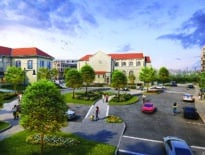
The $400 million Raffles Boston Back Bay is scheduled to begin vertical construction in late 2020 and will include 147 hotel rooms, 146 luxury condos and six restaurants and bars. Image courtesy of The Architectural Team
What a difference a couple of months can make – especially if those couple of months include a global pandemic. As of early 2020, Boston’s high-end urban condominium market was still booming. Record prices, limited inventory, and new units flying off the shelf.
The numbers from the buildings whose sales started over the past few years are impressive: 22 and 50 Liberty – sold out. Millennium Tower, The Pierce and Slip 65 – three buildings, three different neighborhoods, three different price points; nearly 650 units between them – sold out. One Dalton – 80 percent sold at record-setting prices. Thirteen buildings have started sales in the past five years, and between them, nearly 1,500 out of a collective 1,700 units have been sold.
Now, following three months of quarantine, many are asking on a daily basis what the new world of social distancing means for the future of urban living. Certainly, in a time of quarantine, downtowners become envious of those with backyards and uncrowded streets. And so, people ask, will the “new normal” include forsaking cities like Boston to move back to the ‘burbs?
Look to History for Answers
To answer that question, one needs to look at the history of movements in and out of cities over the past century. In the aftermath of the Industrial Revolution, cities were the places to be, the places where the jobs were. The wave of immigration into this country in the early 20th century added more bodies to the nation’s most industrious cities, and while suburban neighborhoods existed, they were nowhere close in size and scale to the suburbia we know today.
Beginning in the late 1950s, however, as the interstate highway system was built and virtually every American family acquired a car, the suburban exodus began. People began leaving cities for the suburbs in droves. With the promise of green lawns, shopping they could drive to rather than walk to and an easy trip down the interstate into the city, much of the balance of the 20th century became the era of “suburban sprawl.”
Something happened, though, toward the end of the last century. Roads became more and more crowded as the sprawl continued unchecked. People began missing the sense of community that denser living gave them. They grew tired of sitting in the car, alone, to go anywhere and to do anything. For those with kids at home, they found their community on the sidelines of the soccer field, but for those without school-age children, as well as for empty nesters, the suburban sprawl began to feel lonely and isolating. And so, they started moving back into cities.
Urban centers from Boston to Austin have boomed over the past 20 years, a trend that was accelerating right up until the spread of COVID-19. Approximately 100 million Americans make up the generations most likely to have school-age children at home – Generation X and the older Millennials. But those without children or with an empty nest – the Baby Boomers, younger Millennials and older Generation Z (excluding those under 17) – add up to around 140 million Americans. And both groups have been flooding downtowns. Whether an empty-nester or a post-college professional, the desire had never been higher for on-street interactions and for cafes, restaurants, bars and cultural attractions that lie within walking distance, a lifestyle that is only available in an urban setting.
Price Appreciation Follows Density, Transit
Several years following the end of the last recession, we conducted a study to learn where home price growth was strongest post-recession. What we found was that 19 of the 20 neighborhoods with the strongest appreciation had at least one of the following three characteristics: they were in Boston proper, they contained a public transit stop and, if they were in suburbia, they had an amenity-filled, walkable town center. Cities and towns with similar housing stock, but without one of the above three characteristics, did not see their home values appreciate similarly to those that met at least one of the above criteria. A sense of community, or ready access to community density, mattered most.
Even among new construction’s multi-unit buildings, the paradigm has shifted over the past 20 years. Residences have shrunk; common spaces and amenities have grown. People want to spend more of their time with others in their building, and less time alone in their units. And that trend was accelerating right up through March.
So, will that trend come to an abrupt halt due to the pandemic? What we have seen since quarantine orders were issued would actually argue the opposite. What is the first thing everyone started to do once they were locked down? Set up Zoom calls with friends, family, or just about anyone with an Internet connection. Open their windows at 7 p.m. and take part in a community sing or cheer. And what is the behavior that has scientists most concerned about a resurgence of the disease? People running out to socialize the second lockdown orders ended.
Modest Supply Will Support Prices
Public officials are begging people to keep their 6-foot distances, not to congregate in large groups, to stay out of indoor restaurants and bars. But all over the country, people are venturing out as soon as allowed (and sometimes sooner), craving the community lifestyle they were forced to live without. With people struggling to make it even four months without satisfying their need for community, it is very difficult to imagine that there will be a permanent shift away from vibrant cities such as Boston.

Jordan Warshaw
At Raffles Boston Hotel and Residences, currently under construction in the Back Bay, we have designed a building with 16 different spaces where people can meet and socialize, ranging from comfortable, intimate residents-only spaces to comfortable, intimate public bars and restaurants for residents, hotel guests and members of the community. Our entire design has been based around the concept of community.
In all of Boston, there are only 10 condominium buildings right now in pre-sale, with only 980 units between them, and only three more buildings with under 500 units between them in early construction or planning stages. With such a modest supply coming to market, and with the pent-up demand to return to community-focused living as soon as COVID-19 is in the rear–view mirror, prospects for urban living in Boston remain bright.
Jordan Warshaw is president of Boston-based Noannet Group, which is partnering with Saunders Hotel Group and Cain International on the Raffles Boston Back Bay Hotel and Residences.




 |
| 

